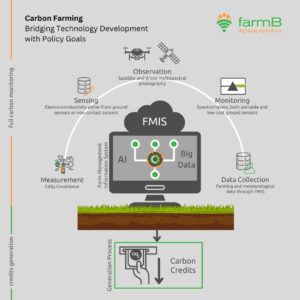Technology paving the way towards issuing tradable carbon credit certificates
Carbon farming potential and its possible impact on environmental policy goals, sustainability, food security, soil fertility, crop yield and economy, forced farmB R&D team in cooperation with scientists from iBO/CERTH, Agricultural University of Athens, University of Linkoln and University of Turin to study and link theoretical advancements and practical applications towards sustainable carbon farming.
The study identified carbon farming potential and some of its main practices for cropping. What is more it delved into the ever-growing market’s response to carbon farming, the structure of monitoring, reporting, and verification methodologies and the barriers that must be addressed.

Soil Organic Carbon (SOC) Sequestration measurement
In terms of estimating SOC sequestration, the study identified the needed procedure that includes sampling design and other labor-intensive traditional methods for SOC stock calculation and also introduced other cost-effective emerging methods that focus on the field-scale. Among those, there are various spectroscopy methods such as Vis-NIR, MIR and XRF, the Eddy Covariance method, Electrical Conductivity and its positive effect in combination with other methods, and Remote Sensing techniques.
The storage and combination of data derived from traditional and emerging SOC measurement techniques along with farming and meteorological data from the Farm Management Information System (FMIS) can provide a strong base for SOC modelling with the help of AI algorithms. The establishment of a carbon monitoring system as such can eventually lead to farmers easy access to tradable carbon credit certificates and thus allowing them to reap the benefits of carbon farming while also having a positive impact on the environment.


